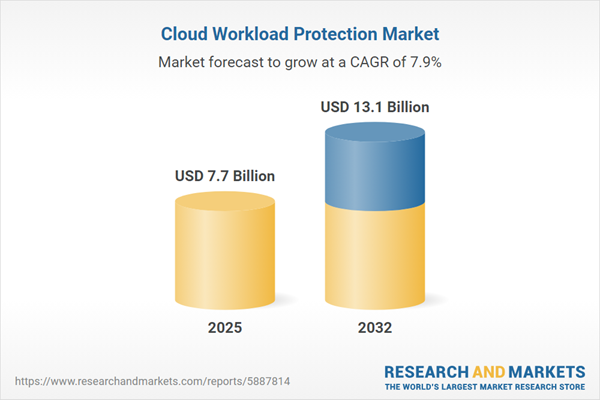Speak directly to the analyst to clarify any post sales queries you may have.
Cloud workload protection is increasingly essential for organizations navigating complex IT environments and rising security threats. This market is evolving as businesses demand resilient, agile, and compliant solutions that address the latest operational challenges and regulatory requirements.
Market Snapshot: Cloud Workload Protection Market Overview
The Cloud Workload Protection Market grew from USD 7.13 billion in 2024 to USD 7.70 billion in 2025 and is projected to reach USD 13.10 billion by 2032 at a CAGR of 7.88%.
This growth reflects a prioritization of adaptive security to support continual digital transformation and safeguard distributed workloads.Scope & Segmentation of the Cloud Workload Protection Market
- Workload Types:
- Container platforms using Docker Swarm and Kubernetes orchestration
- Serverless computing environments with stateless isolation
- Virtual machines requiring persistent runtime oversight
- Deployment Models:
- Cloud-based solutions for rapid scalability and centralized management
- Hybrid deployments that balance performance and regulatory objectives
- On-premises platforms delivering control over data residency
- Service Types:
- Agent-based solutions offering granular visibility
- Agentless approaches leveraging APIs and orchestration integrations
- Organization Sizes:
- Large enterprise deployments requiring extensive customization
- SMB-focused solutions emphasizing ease of use and predictable pricing
- Industry Verticals:
- BFSI focusing on stringent data sovereignty
- Government and Defense demanding audit-ready controls
- Healthcare adhering to strict patient data requirements
- IT and Telecom emphasizing performance and edge scenarios
- Retail focusing on e-commerce and transaction security
- Geographic Coverage:
- Americas including North America (United States, Canada, Mexico) and Latin America (Brazil, Argentina, Chile, Colombia, Peru)
- Europe, Middle East & Africa covering countries such as the United Kingdom, Germany, France, Saudi Arabia, South Africa, and others
- Asia-Pacific with economies like China, India, Japan, Australia, South Korea, and more
- Leading Companies Assessed:
- Trend Micro Incorporated
- Palo Alto Networks, Inc.
- CrowdStrike Holdings, Inc.
- Microsoft Corporation
- Broadcom Inc.
- McAfee, LLC
- Check Point Software Technologies Ltd.
- Cisco Systems, Inc.
- Fortinet, Inc.
- SentinelOne, Inc.
Key Takeaways for Senior Decision-Makers
- Modern cloud workload protection strategies provide deep visibility and policy-driven enforcement at the workload level, rather than relying only on traditional network perimeter defenses.
- Segmenting workloads and applying contextual policies that adapt dynamically empower enterprises to mitigate risk across both hybrid and multi-cloud environments.
- Purpose-built security mechanisms integrate with DevOps pipelines, enabling organizations to automate compliance and enhance security without impeding development cycles.
- Industry-specific needs, such as financial data sovereignty or healthcare compliance, drive demand for specialized solutions tailored by vertical.
- The shift toward agentless, API-driven models supports operational agility by reducing deployment complexity while maintaining robust security controls.
- Partnering with leading providers enables organizations to leverage innovations in workload-centric analytics, real-time threat detection, and evolving access management frameworks.
Tariff Impact: U.S. Trade Policy and the Cloud Workload Protection Value Chain
Scheduled U.S. tariffs in 2025 introduce cost pressures on hardware components fundamental to on-premises and hybrid cloud security. This dynamic is leading vendors to adapt supply chains and shift to flexible, subscription-based business models. Enterprises are diversifying infrastructure architectures by exploring cloud migrations, edge deployments, and micro data centers, while regional supply chain adjustments are helping to mitigate tariff-driven expenses. These market changes underscore the broader influence of geopolitical events on security investment and deployment decisions.
Methodology & Data Sources
This report is built on in-depth primary interviews with cybersecurity leaders, combined with secondary research from open-source threat intelligence, regulatory sources, and industry publications. Case study analysis delivers real-world perspectives on deployment strategies and measurable outcomes, ensuring all insights are practical and well-validated.
Why This Report Matters
- Provides a clear analysis of evolving technologies and best practices in cloud workload protection for informed decision-making.
- Highlights strategic responses to regulatory, technological, and supply chain developments affecting enterprise security operations.
- Supports leaders in optimizing workload-centric security strategies to maintain compliance, operational resilience, and business competitiveness.
Conclusion
As cloud environments grow more dynamic, aligning protection strategies to workload demands remains a top priority. Comprehensive analysis and clear benchmarks empower organizations to strengthen digital infrastructure now and into the future.
Additional Product Information:
- Purchase of this report includes 1 year online access with quarterly updates.
- This report can be updated on request. Please contact our Customer Experience team using the Ask a Question widget on our website.
Table of Contents
3. Executive Summary
4. Market Overview
7. Cumulative Impact of Artificial Intelligence 2025
Companies Mentioned
The companies profiled in this Cloud Workload Protection market report include:- Trend Micro Incorporated
- Palo Alto Networks, Inc.
- CrowdStrike Holdings, Inc.
- Microsoft Corporation
- Broadcom Inc.
- McAfee, LLC
- Check Point Software Technologies Ltd.
- Cisco Systems, Inc.
- Fortinet, Inc.
- SentinelOne, Inc.
Table Information
| Report Attribute | Details |
|---|---|
| No. of Pages | 191 |
| Published | October 2025 |
| Forecast Period | 2025 - 2032 |
| Estimated Market Value ( USD | $ 7.7 Billion |
| Forecasted Market Value ( USD | $ 13.1 Billion |
| Compound Annual Growth Rate | 7.8% |
| Regions Covered | Global |
| No. of Companies Mentioned | 11 |









